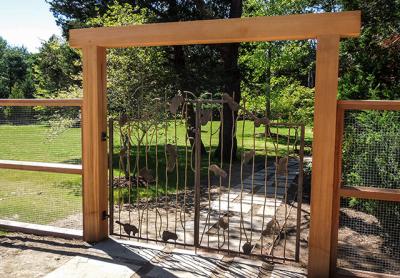Dishing on Design: Daring, Yes, but Not Precious
Dishing on Design: Daring, Yes, but Not Precious

At the recent Architectural Digest Design Show in Manhattan, a panel about daring design turned into a more free-form discussion of trends, clients, art, backgrounds, and big budgets, much to the delight of the crowd of practicing and aspiring designers assembled in the fair’s auditorium on Pier 94.
The participants were three designers who are no strangers to the South Fork, and Fern Mallis, the force behind New York’s Fashion Week for many years and a sought-after interviewer and author with a popular series at the 92nd Street Y, who also has a bungalow retreat on Big Fresh Pond in Southampton.
The panel featured John Loecke and Jason Oliver Nixon of Madcap Cottage design of New York and North Carolina, whose first professional project was a cottage on Meeting House Lane in Southampton, and Joe Nahem, who has a house on Further Lane that was part of last year’s East Hampton Historical Society house tour.
Asked about a daring design detail, Mr. Nahem spoke about the residence off Main Street that he designed for Robert Downey Jr. and Susan Downey. In a late-19th-century house, he suggested, and they agreed to, a sunken living room and a fireplace with a wraparound ceramic wall by Peter Lane. “It was great to see the material and then blow it up to 20 times its size,” Mr. Nahem said.
Mr. Loecke and Mr. Nixon are working on a 40,000-square-foot Georgetown “newish-build” mansion that they are decking out in Robert Adam-style neo-classical plaster architectural details and inlaid floors with different patterns. “We want it to look like the great country houses of England,” Mr. Loecke said.
While not dishing on their clients, they answered Ms. Mallis’s questions with candor, including their most expensive jobs — $10 million and $12 million with construction — and how they persuade clients that their prized piece of artwork might not work with the couch they picked out for the room.
“Most people want their home to feel like someone lives there and is not a museum. It’s a challenge to balance that,” Mr. Nahem said. “You don’t want it to feel like you are in a gallery or can’t watch TV and eat popcorn on the couch.”
While they can often travel around the country or around the world in search of objects for their design projects, Mr. Nahem said, “It’s not glamorous at all. I tell interns all of the time, we’re not riding on private jets or the back of limos, mostly we’re riding the subway with a lampshade. We’re basically two steps above a body shop in Queens.”
In their younger days, they were often accumulating, but now are trying to keep their inventory of furniture and objects spare. “We’re more selective now,” Mr. Nixon said. “We don’t want to have an inventory of stuff we’re beholden to.”
Mr. Nahem said he buys when he sees something he has a specific use for or “when I see something I don’t want another designer to get, I’ll buy it.”
As to the internet, all three said it has changed things for them. “Clients used to come with pages ripped out of magazines and we had to figure out what they wanted . . . . Now with Pinterest they come to us with 7,200 pins and we have to say the opposite, ‘What is it you really like?’ ” Mr. Nahem said.
Like most designers, Mr. Nixon said they had a strong presence on Instagram. “We get a lot of business from it, and most of our current clients.” Tracing the general interest in design back to the first publication of Domino magazine, Mr. Nixon said there has been a clear democratization of design “where good design is available to all. It started with Martha Stewart at Kmart” and has continued, including with their own products now selling at Steinmart and on the Home Shopping Network. “Our sheets at home are from HSN. We’re not going to sell a product I wouldn’t use in my own home. If I find something at Ikea or Pottery Barn that works in a design, you bet I’m going to use it!”








